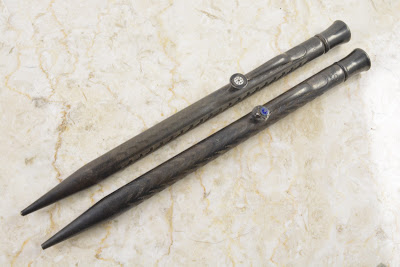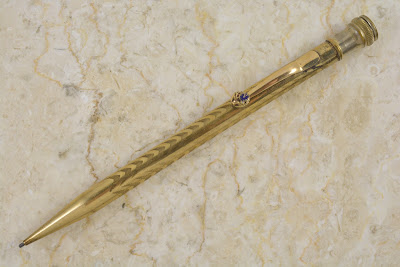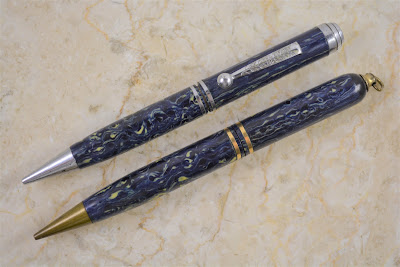This article has been edited and included in The Leadhead's Pencil Blog Volume 5; copies are available print on demand through Amazon here, and I offer an ebook version in pdf format at the Legendary Lead Company here.
If you don't want the book but you enjoy this article, please consider supporting the Blog project here.
This story begins at the Chicago show last May, when David Nishimura’s eyes were bigger than his carry on bag. Since he knew I drive a truck that encompasses two time zones to shows, he asked if I wouldn’t mind hauling a few things home with me and bring them to him at the next show he’d be in a car. One was a large cardboard box with a lamp in it, and the other was a mysterious equally large wooden box, heavy and clunky with a large metal doohickey in it that, even after I peeked a bit to see what it was, I have no idea what it is. I do hope someday he writes about it.
As a thank you for being his mule, he bequeathed an interesting pencil to me:
On the opposite side, this one is imprinted “Pheasant Auto Pencil.”
In addition to a weird name I had not seen before, this one possesses a bizarre, Viking battleax-like clip, topped with what looks like a mismatched cap which twists to operate a screw drive mechanism:
The clip has curious numbers 1 and 2 on either side of that lower retainer:
All of my searching was for naught, with only a hint of a suggestion this one might be British . . . at least, the only mentions I’ve been able to find of a Pheasant Auto Pencil were pictures in auction listings over in the UK. David didn’t say where he got this one, but since he’s more well-traveled than I am it may very well have found its way across the pond and into his hands.
And that, until just the other day, is where this article was going to end . . . an unsatisfying, back-of-the-milk-carton “have you seen me?” sort of post, little more than a desperate attempt to flush out more information by throwing out all I know and see if it rings a bell with anyone.
Then I went to put it away . . . this one was going on the wall o’ pencils just because that clip is far too cool to hide in the drawer of a printer’s cabinet. I grasped the clip and was putting it in alphabetical order, in between my Picks and a “Phoenix,” when something popped.
My heart stopped in that way we’ve all felt when we think we’ve broken something we probably won’t be able to replace anytime soon. For a moment I couldn’t bear to look, and when I did, the cap was noticably higher than it was. Cringing a bit, I twisted the cap and it seemed all right . . . so I pushed it and it neatly clicked back into the same position.
Living up to my self-deprecating and self-imposed nickname of “Leadhead,” I again held the clip and went to put it in place, more gingerly this time, and it popped again. The light began to dawn on me. You don’t suppose . . .
The pencil didn’t have a lead in it, so I fished out a piece and tried it. Standard .046" leads weren’t big enough, but fortunately my Legendary Lead Company stocks some really weird sizes – one of which, .050 inches in diameter, I’ve never used because I’ve never found a pencil it fits. Until now. And with the perfect size of lead, I learned that the pencil advances smoothly into writing position, but when the clip is lifted ever so slightly . . .
The top pops up to retract the lead so you can’t doodle inadvertently in your shirt pocket.
OK, this is still a cry for help, if anyone has any information regarding who made this or can point me towards any advertisements or other information, I’m all ears. But for now, at least I got to show you both a pencil I know nothing about and just about the neatest feature I’ve ever seen on any pencil!
























































